2011 YAMAHA YZ250F MOTOCROSS TEST: THE LAST 250 FOUR-STROKE MOTOCROSS BIKE WITH A SPRITZEN-PUFFER
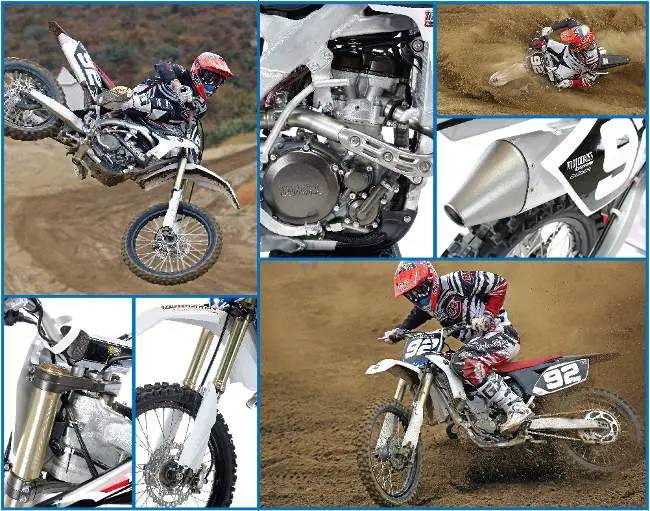
Q: FIRST AND FOREMOST, IS THE 2011 YZ250F BETTER FOR MOTOCROSS THAN THE 2010 YZ250F?
A: No.
Q: HOW MANY CHANGES WERE MADE TO THE 2011 YAMAHA YZ250F?
A: The 2011 Yamaha YZ250F gets a goose egg in terms of the number of quality updates made to the old war horse. To be fair, Yamaha did change the color of the lower radiator shroud (from black to white) and slapped on bold new graphics.
Yamaha can be given a pass on the 2011 model for two reasons:
(1) You gotta sell bikes to finance the R&D on new bikes. The recession has hit the motorcycle manufacturers severely and they couldn’t afford too many projects at one time.
(2) In 2010, Yamaha pumped out a laundry list of changes to the YZ250F (we counted 42 total updates). The blue crew rebuilt the frame, massaged the engine, changed the length and profile of the exhaust system, strengthened the gears, decreased the size of the oil tank, lowered the radiators, put the gas tank on a Jenny Craig diet, revised the ergonomics and updated the body styling.
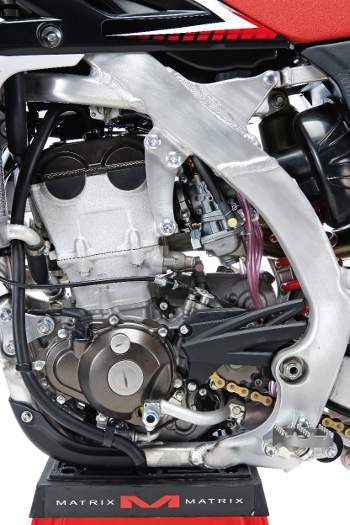 |
| Mix and match: This is an old engine in a new package. |
The MXA wrecking crew was satisfied with Yamaha’s 2010 updates. With that said, the abundant changes last year did little to improve the overall performance of the bike. When it came time for our celebrated MXA 2010 250 shootout, the YZ250F finished in third place. Its placement in the pecking order only tells a fraction of the whole story. In 2010, the Kawasaki KX250F and KTM 250SXF finished well ahead of the YZ250F in one major category: powerband. In the 250 class, horsepower rules the roost, and the 2010 YZ250F didn’t have the power profile that MXA test riders yearned for.
While every other manufacturer made updates to their 250 four-strokes for 2011, Yamaha put R&D on hold to save money. It might not hinder Yamaha’s sales, as the YZ250F has been one of the best-selling bikes in its category. Still, as a magazine that lives to test new machinery, we were disheartened when we discovered that Yamaha made two changes to the bike, both of which were merely cosmetic.
Q: WHAT WERE WE HOPING THAT YAMAHA WOULD IMPROVE WITH THE 2011 YZ250F?
A: The answer is easy. Every MXA test rider has wanted a new engine for almost a decade. And the new engine needed to come with a wider powerband. In last year’s 250 shootout, the YZ250F ranked fourth out of five in the category of “best overall powerband.” Over the years, Yamaha has made incremental revisions to their bulletproof engine, but we were hoping that the engineers would kick out the jams and redefine the powerplant.
The Yamaha YZ250F is the king of bottom-end power. This isn’t something to be proud of. In a world where 250 four-stroke riders bang their engines off the rev limiter, the low-to-low YZ250F powerband is left in the dust. There are three viable options for improving the engine, ranging from cheap (gearing) to fairly expensive (aftermarket exhaust systems) or exorbitant (engine work).
Q: HOW DOES THE 2011 YAMAHA YZ250F COMPARE TO LAST YEAR’S MODEL ON THE DYNO?
A: This is a trick question, but we will answer it anyway. The trick is that Yamaha didn’t make any changes to the YZ250F engine for 2011. A dyno chart does not recognize new graphics and different-colored plastic as statistical factors. Still, we ran the 2011 YZ250F on the dyno just to make sure.
Maximum horsepower on our 2011 YZ250F was 35.88 ponies at 11,500 rpm. Maximum torque was 18.95 foot-pounds. These numbers were identical to the 2010 bike’s. Two years ago, the 2009 YZ250F reached a healthier 36.41 horsepower at 12,000 rpm. Maximum torque was 19.19 foot-pounds. The 2011 engine has a 1/2 horsepower advantage from 6200 rpm through 6800 rpm, but the 2009 engine had a 1-1/2 horsepower advantage at 10,000 rpm.
Why does the engine produce stronger bottom-end dyno numbers than it did two years ago? In 2010, Yamaha made several internal changes designed to boost bottom-end power. A year later, we’re still left dumbfounded as to why Yamaha went for bottom-end power only instead of more midrange oomph.
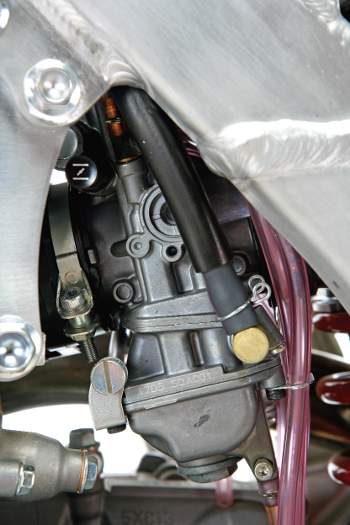 |
| Museum piece: This is a Kehin FCR carb. Take a good look at it. Someday, when your electronics fire, you will miss the old-fashioned mechanical carb. |
Q: SHOULD YAMAHA OUTFIT THE YZ250F WITH ELECTRONIC FUEL INJECTION FOR 2012?
A: Let’s face it, riders are becoming more comfortable with electronic fuel injection. It’s human nature to appreciate technology that generally makes life easier. Fuel injection is one such technology. A sensor system in the throttle body takes various air, fuel and engine readings and immediately adjusts for the conditions. Gone is the hassle of changing needles, raising or lowering the clip, or swapping out jets. Most riders happily bid adieu to carburetors that spritz fuel via vacumn, but the MXA wrecking crew still has a soft spot for the organic feel of old school carbs. We’ve discovered, on more than one brand, that fuel injection has cut an otherwise potent engine off at the knees, effectively turning it into a vacuum cleaner; it has power, but no spunk. With fuel injection comes a gamble in engine performance. If the fuel injection is not mated properly with the powerplant, many fuel-injected bikes are slower than their carbureted brethren.
Does the Yamaha YZ250F need an electronic fuel system? No?it needs work in other areas way before its carb. Do we expect the 2012 YZ250F to be EFI equipped? Certainly, but economics are a factor that can’t be ignored. We were surprised last year when the YZ250F didn’t come with EFI, since Yamaha went to the trouble of reshaping the frame and changing the profile of the bottom of the gas tank (key elements in EFI system acceptance). Regardless of whether Yamaha can afford it or not, motorcycle manufacturers must bow to public opinion. Riders want hands-free simplicity, which in this case means fuel injection. We just hope that Yamaha’s move to EFI doesn’t come at the expense of engine performance on an engine that can’t afford to sacrifice any more performance. It should be noted that the Yamaha is the only carbureted 250 four-stroke left (KTM and Husqvarna joined the EFI fraternity in 2011).
Q: HOW IS THE JETTING ON THE 2011 YAMAHA YZ250F?
A: Last year, Yamaha cleared any burps and bogs in the Keihin carburetor with richer jetting specs. The main jet, pilot jet and needle were adjusted slightly for instantaneous throttle response and better low-end response. The venturi on the Keihin FCR MX37 carburetor was taper bored to improve bottom-end hit. We’re happy to report that Yamaha’s jetting settings are satisfactory. A slight adjustment to the fuel screw was all that the YZ250F needed for most riding conditions at sea level.
Here are MXA‘s recommended jetting specs (stock settings are in parentheses):
Mainjet: 180
Pilot: 45
Needle: NDJR
Clip position: 4th from top
Fuel screw: 3/4 turn out (1-3/4 turns out)
Leak jet: 70
Notes: For high altitude, we recommend switching to a 178 mainjet with the clip in the 3rd position. For cold weather, we recommend swapping the 180 mainjet for a 182 and adjusting the fuel screw to 2-1/4 turns out.
Q: WHAT IS THE RETAIL PRICE OF THE 2011 YAMAHA YZ250F?
A: The 2011 Yamaha YZ250F retails for $7150 in blue or $7250 in the phantom red/white/black version. In comparison to the Honda CRF250 ($7199), Kawasaki KX250F ($7299), Suzuki RM-Z250 ($7299) and KTM 250SXF ($7699) the Yamaha YZ250F has the lowest price tag. This is a big plus for those looking to pinch pennies?and who isn’t?
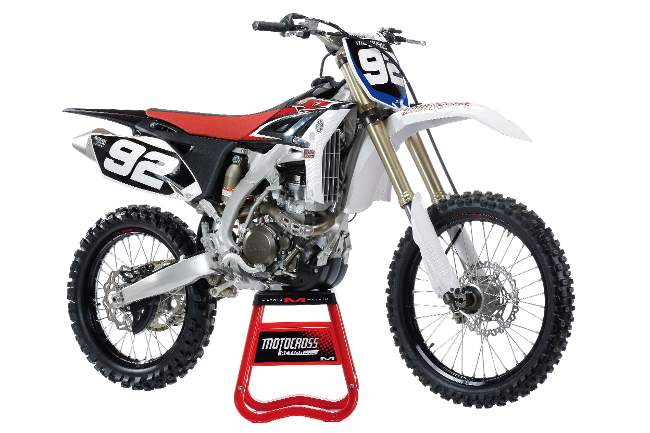
2011 Yamaha YZ250F: With the exception of the engine, the Yamaha YZ250F was totally new in 2010. Guess what? It is still totally new in 2011, because Yamaha made no changes for 2011?save for the color of the plastic.
Q: WHAT ARE OUR BEST FORK SETTINGS?
A: Slower and smaller riders can get away with using the stock 0.45 kg/mm fork spring, but heavier riders (over 160 pounds) should jump up a spring rate. Doing so will keep the forks up in their stroke and help prevent the forks from diving.
For hardcore racing, these are MXA‘s recommended 2011 Yamaha YZ250F fork settings (when changed, stock settings are in parentheses):
Spring rate: 0.46 kg/mm (0.45 kg/mm)
Oil quantity: 340cc (350cc stock)
Compression: 2 clicks out (8 clicks out)
Rebound: 8 clicks out (10 clicks out)
Fork leg height: 5mm up
Notes: Slower and smaller riders shouldn’t have a problem with the stock fork spring rate, but those over 160 pounds should seriously consider jumping up a spring rate. This will allow the forks to remain up in their stroke and keep the forks from diving in braking and deceleration. Even with the stock fork springs, we lowered the oil height by 10cc to get rid of some serious mid-stroke harshness.

Q: WHAT IS OUR BEST SHOCK SETTING?
A: In stock trim, the Kayaba suspension isn’t very well-balanced. Yamaha is close in their baseline settings, but the shock feels high in its stroke. We increased the race sag to 105mm (Yamaha recommends 100mm). We also slowed down the rebound and went in on low-speed compression.
Here is what the MXA wrecking crew ran in its 2011 YZ250F (stock settings, when changed, are in parentheses):
Spring rate: 5.3 kg/mm
Race sag: 105mm
Hi-compression: 2-1/4 turns out (1-3/4 turns out)
Lo-compression: 7 clicks out (9 clicks out)
Rebound: 9 clicks out (10 clicks out)
Notes: Riders who don’t need heavier fork springs should make as many race sag adjustments as necessary?they could go to 110mm.
Q: WHAT DID WE DO TO MAKE THE YAMAHA YZ250F WORK BETTER?
A: We dealt with three problem areas on the 2011 YZ250F. These issues can be fixed, albeit with a slight hit to the pocketbook. Steer your cash flow toward these areas:
(1) Gearing. Step number one in maximizing the short powerband is to gear the YZ250F taller. Read that carefully, because we don’t gear the YZ250F down; we gear it up by putting a smaller rear sprocket on the bike. Although it won’t increase the powerband, it will increase how long the short powerband works.
(2) Forks. For years we raved about the Kayaba SSS forks. They were far and away the best stock forks on the market, needing only a clicker adjustment here or there to dial them in. On the 2011 YZ250F, that is not the case. We believe the latest frame geometry puts too much weight on the front end. Yamaha decreased the high-speed compression damping while increasing high-speed rebound damping and low-speed compression damping. Installing stiffer fork springs, lowering the oil height, and going in on compression will vastly improve the front end.
(3) Exhaust system. The YZ250F benefits from an aftermarket exhaust system. Last year, we tested exhausts from six different companies (January 2010 issue). Two particular systems stood out: The Pro Circuit Ti-4R system offered the best midrange to top-end improvement, while the Yoshimura RS-2 was preferred by every level of rider.
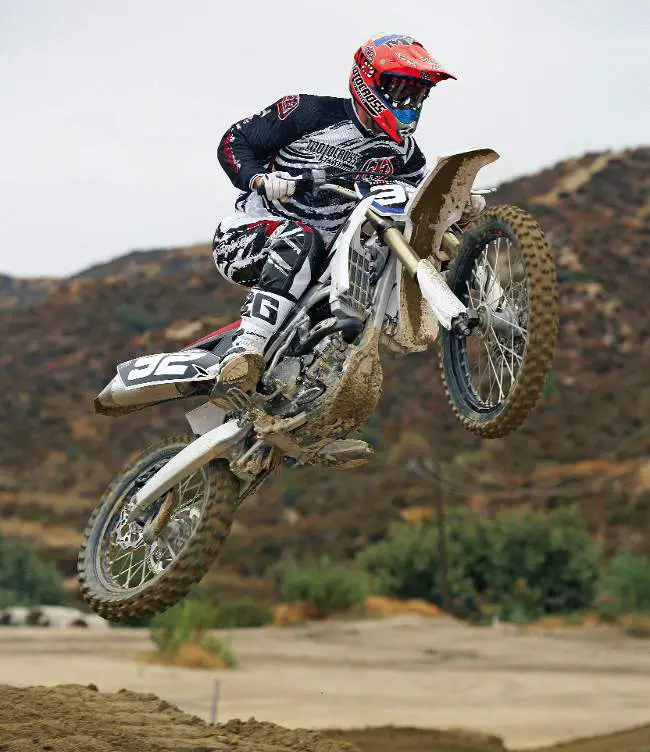
Pros and cons:?The 2011 YZ250F is a good bike, but not a great bike. Its biggest plus is that it is a very reliable 250cc four-stroke. It has acceptable handling, a creative frame and great shock. On the minus side, the powerband is too single-purpose.
Q: WHAT DO WE HATE?
A: The hate list:
(1) Engine. We have longed for an updated YZ250F powerplant for 10 years. The current low-end-happy engine simply doesn’t cut it in the hands of fast riders. As we said last year, maybe we’ll get our wish next year.
(2) Forks. Kayaba’s SSS forks were our favorite in the 250F class. What happened? The spring rates, oil height and damping specs are off.
(3) Gearing. The stock 49-tooth rear sprocket doesn’t help the punchy bottom end. By using a smaller rear sprocket, we broadened the powerband to end the need to shift every 15 feet. Switch to a 48-tooth sprocket.
(4) Updates. We understand that the economy has been floundering for several years and that bike updates are hard for a manufacturer to justify, but this was a bike that needed some engine work?at the very least.

Yamaha’s strategy with the 2011 YZ250F is to sell a reliable, trustworthy and capable bike without going bankrupt doing it. The hope that potential buyers are on the same page.
Q: WHAT DO WE LIKE?
A: The like list:
(1) Frame. The 20-piece bilateral beam frame is stronger than any previous model YZ250F frame, with increased lateral and torsional rigidity. Those improvements add up to a better-handling chassis.
(2) Longevity. Apart from 2006, when the stock intake valve broke, the YZ250F has been very reliable. There is something admirable about a durable 250 four-stroke.
(3) Carburetor. Call us old fashioned, but we like the luscious feel of a Keihin FCR carb. On a given engine, a carb will make more horsepower than fuel-injection. It may not be as crisp off idle, but it will run better. Jetting on the 2011 YZ250F is not an issue.
(4) Handlebar mounts. We like the four handlebar mounting options on the YZ250F. Taller test riders enjoyed the mounts in the second position (forward holes, but with the mounts turned rearward).
(5) Footpegs. The 2-1/4-inch-wide titanium footpegs are lightweight and offer a great rider interface. It’s always nice when footpegs are free and clear of mud after riding. The YZ250F pegs are excellent.
(6) Bridgestone tires. Most test riders enjoy Bridgestone’s 403A/404 tire combo. It should be noted that the 403A front tire is a special YZ250F-specific tire that works better than the showroom-available 403.
(7) Clutch. The clutch is smooth pulling and headache free. ‘Nuff said.

Q: WHAT DO WE REALLY THINK?
A: Although the 2011 Yamaha YZ250F has many positive attributes (frame, footpegs, clutch and handlebar mounts), the negatives (powerband, gearing and forks) outweigh the positives. While the competition pushed forward with technological advancements for 2011, the YZ250F remained stagnant. Although the other brands’ tech updates weren’t always beneficial, they did show a desire to improve. Simply put, the YZ250F is getting long in the tooth.





Comments are closed.